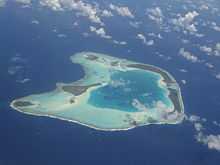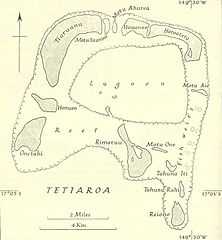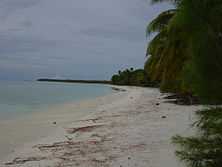Teti'aroa
 Aerial view of the island of Teti'aroa | |
 | |
| Geography | |
|---|---|
| Location | Pacific Ocean |
| Coordinates | 17°0′S 149°33′W / 17.000°S 149.550°WCoordinates: 17°0′S 149°33′W / 17.000°S 149.550°W |
| Archipelago | Society Islands |
| Area | 6 km2 (2.3 sq mi) |
| Country | |
|
France | |
| Overseas collectivity | French Polynesiad |
| Administrative subdivision | Windward Islands |
| Commune | Arue |
| Demographics | |
| Population | 1[1] |


Teti'aroa is a privately owned atoll in the Windward group of the Society Islands of French Polynesia, an overseas collectivity of France in the Pacific Ocean. Once the vacation spot for Tahitian royalty, the atoll is widely known for having been purchased by Marlon Brando.
Geography
Teti'aroa is administratively part of the commune (municipality) of 'Ārue.
The atoll is located 33 miles (53 km) north of Tahiti. The atoll stretches on a total surface of 2.3 square miles (6 square km); approximately 1,445 acres (585 hectares) of sand are divided in 13 motus (islets) with varying surface areas. The lagoon is approximately 4.5 miles (7 km) wide and 100 feet (30 meters) deep. The atoll has no reef opening, making access by boat nearly impossible.
The islets (or motus), in clockwise order starting from the southwest corner, include:
- Onetahi (with regulated airstrip and future site of The Brando Resort)
- Honuea
- Tiaruanu
- Motu Tauvini (Tauini)
- Motu Ahurea (Auroa)
- Hiraanae
- Horoatera (Oroatera)
- Motu 'Ā'ie
- Tahuna Iti (almost out of sight, immersed)
- Tahuna Rahi
- Reiono
- Motu One
- Rimatu'u (with an ornithology reserve)
Ownership and history
The atoll of Teti'aroa holds a special place in the hearts of the people of French Polynesia. It has become almost a “sacred spot” for the people. In historic times, Teti'aroa belonged to the Pomare family, rulers of Tahiti. The royal family placed Teti'aroa in the care of faithful retainers who managed it and lived there.
Members of the royal family spent time on Teti'aroa when they needed quiet time and relaxation. The female members of the family are said to have gone there to eat (gain weight) and stay out of the sun (have their skin lighten up) “for the purposes of beautifying their person.” According to legend, in times of trouble the King placed his treasures there for safekeeping. In 1789, William Bligh is said to have been the first European to visit the atoll while looking for the Bounty mutineers. [2]
In 1904, the royal family gave Teti'aroa to Dr. Johnston Walter Williams, the only dentist in Tahiti. Mr Williams later became Consul of England from 1916 to 1935. [3] Dr. Williams managed Teti'aroa as a residence and a copra plantation.
In 1960, Marlon Brando “discovered” Teti'aroa while scouting filming locations for Mutiny on the Bounty, which was shot on Tahiti and neighboring Moorea. After filming was completed, Brando hired a local fisherman to ferry him to Teti'aroa. It was “more gorgeous than anything I had anticipated,” he marveled in his 1994 autobiography Songs My Mother Taught Me.
Brando eventually purchased Teti'aroa's islets (motus) from one of Dr. Williams’ direct descendants, Mrs. Duran. The reef and lagoon belong to French Polynesia. (Mr. Williams and his wife are buried on motu Rimatuu). Brando purchased most of the atoll in 1966 for $200,000 and the other part in 1967 for $70,000. He had to overcome political interference and local resistance to purchase the atoll. Many important archaeological sites have been located, identified, and studied on Teti'aroa. Thus, the historical significance of Teti'aroa to the people and the government of French Polynesia continue to make future development and/or sale questionable at best.[4]
Wanting to live on the atoll, Brando built a small village on Motu Onetahi in 1970. It consisted of an airstrip to get there without breaching the reef, 12 simple bungalows, a kitchen hut, dining hall and bar, all built from local materials - coconut wood, thatch roofs and even large sea shells for sinks. The village became a hospice for friends, family and scientists studying the atoll's ecology and archeology.
Over the years, Brando spent as much time as he could there and used it as a getaway from his hectic life in Hollywood. Although he didn’t spend as much time there as he wished, it is said that he always cherished his moments on Teti'aroa.
Eventually the village became a modest hotel managed by his Tahitian wife, Tarita Teriipia, who had played his on-screen love in Mutiny on the Bounty. The hotel operated for more than 25 years, even after Brando left French Polynesia to return to Los Angeles. Many hotel guests lamented the lack of amenities normally found at an island resort.[5]
In 1980, the famous maxi yacht S/Y Condor of Bermuda ran aground on the Onetahi reef, which caused it to be shipwrecked and written off by insurers. Purportedly, Brando and the owner of the yacht engaged in a brief bidding war for rights to the vessel’s polished mahogany hull (as reported by its owner in the New Zealand yachting magazine, Sail in 1981), which Brando, it is believed, wanted to use as a bar at a resort he planned to build on the island. The yacht was salvaged, and sent to New Zealand for repair.
In 2002, two years before the actor’s death, Brando signed a new will and trust agreement that left no instructions for Teti'aroa. Following his death in 2004, the executors of the estate granted development rights to Pacific Beachcomber SC, a Tahitian company that owns hotels throughout French Polynesia.
Future of Teti'aroa
Teti'aroa Pacific Beachcomber SC began construction on Teti'aroa in 2009. The first phase of building included reconstruction and reorientation of the runway, as the original surface was in disrepair and not long enough to meet current aviation regulations. In addition, a reef dock was built to enable the transfer of supplies from the ocean side of the reef to the lagoon side.
When construction is completed, the motu Onetahi will include a luxury eco-hotel (The Brando), spa, research station, staff village and private runway.
The resort is expected to be certified LEED Platinum, the highest LEED certification level possible. LEED is an internationally recognized green building certification system that provides third-party verification that a building was designed and built using strategies aimed at improving performance across all the metrics that matter most, including energy savings, water efficiency, and CO2 emissions reduction.
Using various methods of renewable energy -- solar panels, bio-fuel generators and a sea-water air conditioning (SWAC)) system, as well as innovative wastewater treatment procedures -- the entire resort aims to create a net zero water and energy community. This objective is above and beyond the requirements of LEED and reflects Marlon Brando’s passion for environmental sustainability [citation needed].
References
- ↑ "Where to Stay". Retrieved 16 October 2013.
- ↑ 360 Cities
- ↑ The Tahiti Traveler
- ↑ NASA Earth Observatory
- ↑ "Trouble in Paradise", Matthew Heller, Los Angeles Times, October 23, 2005
Waltzing with Brando by Bernard Judge
External links
| Wikimedia Commons has media related to Teti'aroa. |